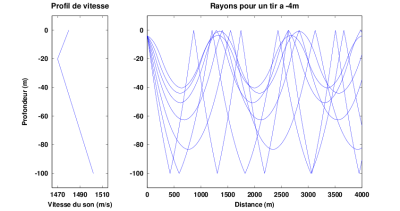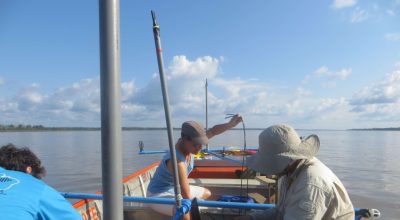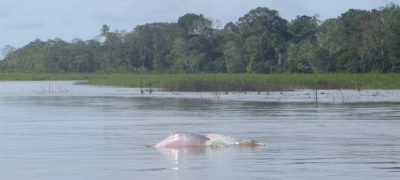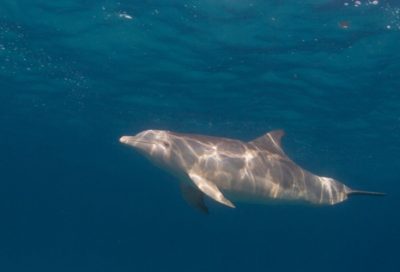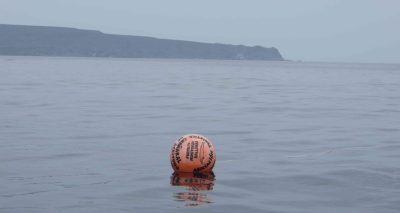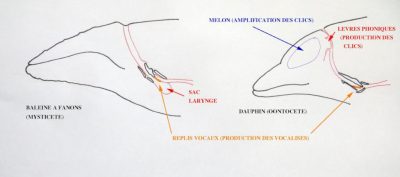Listening to cetaceans
PDF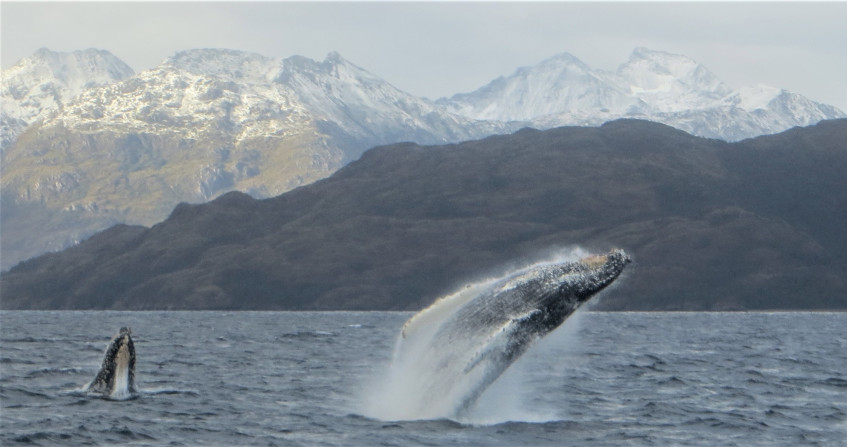
From the famous modulated song of humpback whales to the ultrasound sonar of pink dolphins in the Amazon, the mammals inhabiting the oceans and rivers have developed ways of using sound that amaze us more and more every day. Why sound? What kind of sounds? How can researchers study these modes of communication or location, and what do they tell us about our giant cousins in the seas? These are some of the questions that marine bioacoustics [1], a discipline that combines biology and physics, but also computer science, ecology, data processing and oceanology, is trying to answer.
1. Sound in the ocean
1.1. The Importance of sound waves in water
Water (especially salty water) conducts electricity. As a result, electromagnetic waves (light, radio waves, etc.) propagate quite badly, which explains why the sea is an extremely dark environment as soon as the depth reaches a few tens of metres. Although most marine animals, especially mammals, have very powerful eyes, these cannot be used as effectively as in terrestrial environments, at least not for long-distance exchanges. On the other hand, sound propagates well there, more rapidly than in the air, and is little attenuated. As a result, many marine animals use sound to collect or transmit information, just as humans do for their installations and vessels (submarines, surveillance or geological prospecting devices).
1.2. Physics of sound in the ocean
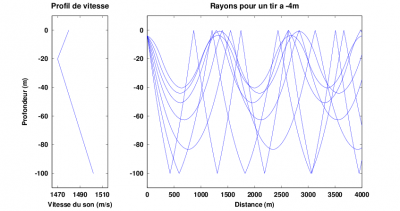
The speed of sound in water varies with depth along the water column. This creates acoustic “waveguides” that allow sound to propagate very efficiently over long distances. The diagram shown in Figure 1, obtained by modelling the propagation of sound in the water by “acoustic rays” shows that the rays coming from the same point, instead of diverging regularly (and possibly being absorbed by the bottom) are channelled into the layer of water corresponding to the minimum of the speed of sound.
1.3. Recording underwater
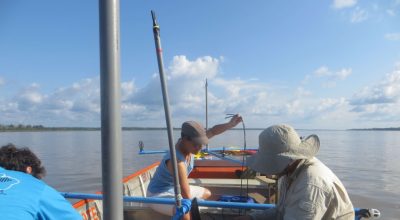
- a sensor, the hydrophone (aquatic microphone), normally based on the properties of piezoelectricity and provided with a soft envelope allowing its acoustic adaptation to the environment;
- a recorder, a device that digitizes the signal (after possibly filtering it) and stores it in a digital form. The digitization step involves the sampling rate and resolution, parameters that will depend on the type of sound being sought.
The signal thus acquired can then be processed or analysed, either manually or by automated procedures (Figure 2).
1.4. View sound
To analyse a sound, acousticians have a tool provided by 19th and 20th century mathematics: the Fourier transform. Thanks to this processing, it is possible to shift the signal from the time domain (pressure varies with time) to the frequency domain. The frequency domain allows a sound to be analysed according to its high frequency or low frequency components, in the same way that a colour spectrum allows the components of a light beam to be assessed. By making certain hypotheses, we can then visualize the sound in a representation called “time-frequency”, which allows us to see its frequency content as a function of time. This representation, based on advanced mathematical theories, allows a visualization close to a musical score!
Video 1. Illustration of the time-frequency representation of a sound. Time is on the x-axis and frequency on the y-axis, with colour representing intensity. We can see that a sinusoidal sound of the whistling type corresponds to an intensity concentrated on a single frequency (here of the order of a kilo Hertz), possibly variable when the sound is modulated. On the contrary, a snap is a short sound (localized in time, here at seconds 6 and 7) but whose energy is distributed over a wide frequency band.
2. Sounds produced by aquatic mammals
2.1. Which aquatic mammals?
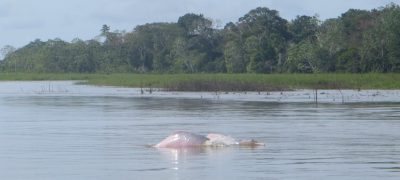
2.2. Examples of sounds produced
Noise emissions from aquatic mammals are extremely varied and cover a part of the acoustic spectrum far beyond human hearing [3]. For example, the largest rorqual whales (blue whales, fin whales, etc.) can produce very intense infrasound for up to a few tens of seconds. These emissions, whose frequency is around ten Hertz, are among the strongest in the animal world: they reach 190 dB (reference 1µPa) at one metre (the level of a large commercial ship at average speed). The intensity of these sounds enables large marine mammals to communicate over distances of several tens of kilometres. In contrast, porpoises and river dolphins emit brief and repeated ultrasounds, called “clicks“, which can reach extremely high frequencies of several hundred kHz.
Between these two extremes, we will also find dolphin whistles (such as those of the bottlenose dolphin, but also those of killer whales or pilot whales) presenting a great variety, often in frequencies perceptible by humans (a few kHz). Similarly, the vocal repertoire of humpback whales has made them the “stars” of underwater bioacoustics, ranging from deep roars to multiple squeaky or modulated sounds that are quite remarkable and accessible to the human ear.
Video 2. Example of sounds produced by the bottlenose dolphin (Tursiops truncatus). We will recognize the whistles, high-pitched, frequency modulated sounds (between 5kHz and 20 kHz), the clicks, short and wide band (of which only a part is recorded here, the rest going too high in frequency for the recording device), as well as short barks at low frequency (around 1 kHz).
2.3. Biological function of some particular sounds
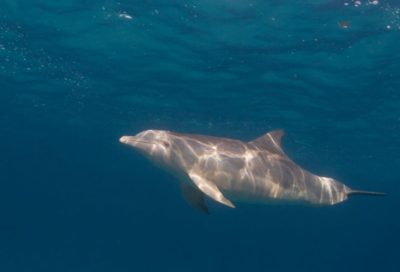
Some baleen whales (or true whales, or mysticetes) emit modulated sounds that are repeated in highly structured series. These series are called “songs”, by analogy with the songs of birds. These songs seem to be the prerogative of males, and therefore probably have a function related to reproduction, such as attracting the attention of females or competition between males. Moreover, these songs are sometimes true dialects, which make it possible to distinguish different populations or clans of the same species (See Focus The decline in frequency of blue whale songs).
A third example is the whistling of some dolphins, such as the bottlenose dolphin (Tursiops truncatus), which has been shown to transmit a “signature” specific to an individual [4]. During the encounter between two individuals, each one repeats his ‘signature’, sometimes until the other one repeats it in turn, probably as a mark of recognition of his interlocutor (Figure 4).
3. Passive acoustic monitoring
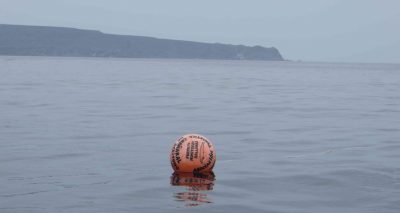
A variety of techniques are used, which allow access to different data, are more or less expensive and have a greater or lesser impact on the object of study. Placing a device directly on the animal under study (“tag”) is undoubtedly the most delicate: several studies have shown that it can modify the behaviour, and in some cases even injure the host [5] – on the other hand, it can lead to spectacular results at the level of an individual, such as the depth at which sounds are emitted, the energy produced, but also to verify which species is at the origin of a given sound.
Other devices are used from a boat:
- these include antennas consisting of several hydrophones towed behind a ship. These techniques are useful for population censuses, allowing “acoustic transects” to be made, which are generally complementary to visual counts.
- the installation of one or more fixed sensors, on buoys or on the bottom, is one of the simplest and least invasive techniques (Figure 5).
These devices generally operate “blind” since no visual data are added to the recorded sounds, but they are safe, inexpensive, durable techniques that allow local, long-term population censuses and the precise study of the characteristics of a particular vocalization.
4. Some results obtained by bioacoustics
In the fifty years of its existence, the bioacoustics of aquatic mammals has produced some interesting advances, of which we highlight a few examples here.
4.1. Physiology
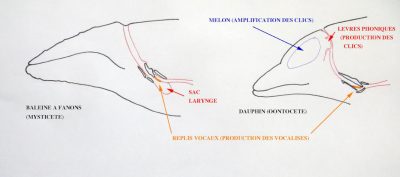
However, studying the physiology of animals of this size is a challenge, since for many species, we only have stranded animals that have been dead for quite a long time. In particular, the mode of sound production by large cetaceans remains largely mysterious. Nevertheless, recent studies mixing dissections of stranded animals, analysis of sound types, physical models reconstructed in the laboratory and computer simulations, have shown two main sources of sound production (Figure 6).
- Vocalizations (whistling, roaring, etc.) are produced by the passage of air through “vocal folds” (an equivalent of the vocal cords, at the level of the larynx) but without expulsion of air, which circulates between the lungs and a closed circuit, the “laryngeal sac” [6].
- The production of “clicks” by odontocetes is due to a specialized organ (the phonic lips). The sound is then amplified in the melon (protruding part of the head of odontocetes, from dolphin to sperm whale). The melon serves to amplify the sound and to focus it in a specific direction.
The knowledge of the role played by the melon has notably given rise to an interesting strategy for the study of sperm whales: the capture and study of the “clicks” emitted by an individual allows to obtain an estimate of its size! Indeed, a series of bounces in the melon can be detected, and the time between bounces makes it possible to evaluate the size of the animal’s head. As this species has a strong sexual dimorphism (males are on average 50% larger than females), we can therefore know whether the individual is an adult male, or whether it is a female or a young male (both having the same size) [7].
4.2. Behaviour
Passive acoustic monitoring also makes it possible – with minimal disturbance – to gain insight into the behaviour of individuals. For example, by recording the clicks of a sperm whale during a dive, its trajectory could be reconstructed. The video below (Video 3) shows the movements of the animal, which reaches a depth of several hundred meters, but also the success of its search for food: it is indeed estimated that an acceleration of the rhythm of the clicks corresponds to an active hunt (the prey is spotted and pursued) and that the silent interval marks the moment of capture and absorption of the prey (a cephalopod in general).
Video 3. Link of the video: click here ! Three-dimensional animation showing the trajectory of a sperm whale reconstructed from acoustic recordings [8]. You can hear the recording and read the time between two clicks. The periods of acceleration of the clicks, followed by a silence, are interpreted as an episode of successful hunting, with capture and ingestion of the prey (usually a squid).
Passive acoustics can also be used to understand the so-called “cultural” behaviour of cetaceans: a study published in 2013 highlighted the transmission of humpback whale songs from east to west in the western South Pacific basin. It was noted that “fashionable” themes towards Australia were taken up by males in New Caledonia the following year, and so on by different populations on an oceanic scale.
4.3. Population census
Counting the individuals of a species is always a difficult exercise; it becomes a challenge for aquatic mammals, for which many of the usual techniques are unusable: it is impossible to find traces or footprints, to place photographic traps…
With a few exceptions (stable coastal populations for example) visual observations are difficult and not very effective. Indeed, cetaceans are discreet, few in number compared to the immensity of the seas, and spend most of their time underwater, invisible. Finally, it is impossible to observe them as soon as weather conditions deteriorate.
It is therefore understandable that bioacoustics has an important role to play in the detection and counting of individuals, as it combines a few advantages:
- surveillance can be conducted day and night,
- the range of the instruments can extend to several tens of kilometres for some species (great baleen whales, in particular),
- the instrument can operate for long periods of time (several months) at a reduced cost.
Despite this potential, the use of passive acoustic monitoring for population censuses is a nascent technique, which is encountering many difficulties [9]. The evaluation of the range of each instrument is a necessary parameter to make a statistical model of density, but it depends on the species, the intensity of the emitted signal, environmental conditions, the topology of the terrain, the response of the instrument… The sound signals emitted by cetaceans are for the moment not distinguishable between two individuals: it is difficult to know if the same individual has been heard many times or if the place is frequented by several individuals. Some species are very vocal at certain times, and totally silent at others, passing unnoticed.
However, it is possible to make comparisons between different acoustic surveys, and thus determine whether a species is stable in a given location, or whether its density varies with the seasons or years. The acoustic behaviour of species is also becoming better known. In addition, sophisticated sound propagation models are now available. Thanks to these tools, many studies have succeeded in overcoming the obstacles mentioned. For example, the very discrete Ziphius, or toothed whales, one of the first specimens of which, stranded on the Côte Bleue near Marseille, was described by Cuvier, are increasingly being identified by passive acoustic monitoring techniques involving a random mesh of floating buoys, capable of perceiving their probes at depth [10].
4.4. Protection
The density calculation described above is an essential means of population management and species protection. All techniques combined (strandings, visual and acoustic surveys, etc.), it has been shown that the Antarctic blue whale (Figure 7) suffered a catastrophic decline in numbers during the middle of the twentieth century, from some 300,000 individuals distributed throughout the southern seas to around 400 individuals recorded fifty years later [11]. Hardly more than one individual in a thousand escaped hunting, over a period of less than the average lifespan of the species! Current estimates tend to show a timid recovery (the number of individuals is currently around 1,000) that is still very fragile, more than 50 years after the first moratorium on blue whale hunting.
Bioacoustics can also be used to develop real-time protective devices. This is the case during underwater geological prospecting, a technique that consists of sending a very strong acoustic pulse into the marine environment to probe the subsoil (a giant ultrasound scan), which is highly invasive for the environment, especially for marine mammals. During these campaigns, scientists are responsible for permanent visual and acoustic vigilance: if cetaceans are spotted in the vicinity, the emissions are interrupted.

5. Messages to remember
- All cetaceans and many pinnipeds use the good propagation of sound in the water to communicate, to find their way around, to feed, to identify dangers…
- The goal of marine mammal bioacoustics is to understand what sounds aquatic mammals emit and what their biological functions are.
- In addition to visual studies, this discipline is also used to identify endangered populations in order to improve their protection.
Notes and References
Cover image. A female humpback whale leaps out of the cold waters of the Strait of Magellan under the interested eye of a fellow whale. [Source: Cliché J. Patris]
[1] At the W. & Hastings M. (2008) Principles of marine bioacoustics. Springer
[2] Wilson D.E. & Mittermeier R.A. (2014) Handbook of the mammals of the world (4) Lynx edition.
[3] Richardson W. J. (1995) Marine Mammals and Noise. USA: Academic press
[4] Sayigh L., Esch C., Wells R. & Janik V. (2007) Facts about signature whistles of bottlenose dolphins, Tursiops truncates. Animal Behaviour, 74, 1631-1642
[5] Andrews R. et al (2019) Best practice guidelines for cetacean tagging. J. Cetacean Res. Manage. 20, 27-66
[6] Reidenberg J. S. (2017) Terrestrial, Semiaquatic, and Fully Aquatic Mammal Sound Production Mechanisms. Acoustics Today, 13 (2), 35-43.
[7] Rhinelander M. (2004) Measuring sperm whales from their clicks: Stability of interpulse intervals and validation that they indicate whale length. The Journal of the Acoustical Society of America, 115, 1826-31.
[8] Benard F. & Glotin G. (2010) Automatic indexing for content analysis of whale recordings and xml representation EURASIP Journal on advances in Signal Processing, 1-8
[9] Marques T. et al (2013) Estimating animal population density using passive acoustics. Biological Reviews 88, 287-309.
[10] Barlow J. et al. (2018) Diving behavior of Cuvier’s beaked whales inferred from three-dimensional acoustic localization and tracking using a nested array of drifting hydrophone recorders. The Journal of the Acoustical Society of America 144(4), 2030-2041
[11] Branch et al. (2007) Past and present distribution, densities and movements of blue whales Balaenoptera musculus in the Southern Hemisphere and northern Indian Ocean. Mammal Rev. 37(2), 116-175
[12] Spaulding E. et al. (2009) An autonomous, near-real-time buoy system for automatic detection of North Atlantic right whale calls. Proceedings of Meetings on Acoustics, 6,1-22 http://www.nrwbuoys.org
[13] NOAA fisheries (2019) Marine Mammal Stock Assessment Reports by Species/Stock: Right Whale, North Atlantic
The Encyclopedia of the Environment by the Association des Encyclopédies de l'Environnement et de l'Énergie (www.a3e.fr), contractually linked to the University of Grenoble Alpes and Grenoble INP, and sponsored by the French Academy of Sciences.
To cite this article: PATRIS Julie (March 9, 2021), Listening to cetaceans, Encyclopedia of the Environment, Accessed October 27, 2024 [online ISSN 2555-0950] url : https://www.encyclopedie-environnement.org/en/life/listening-to-cetaceans/.
The articles in the Encyclopedia of the Environment are made available under the terms of the Creative Commons BY-NC-SA license, which authorizes reproduction subject to: citing the source, not making commercial use of them, sharing identical initial conditions, reproducing at each reuse or distribution the mention of this Creative Commons BY-NC-SA license.








